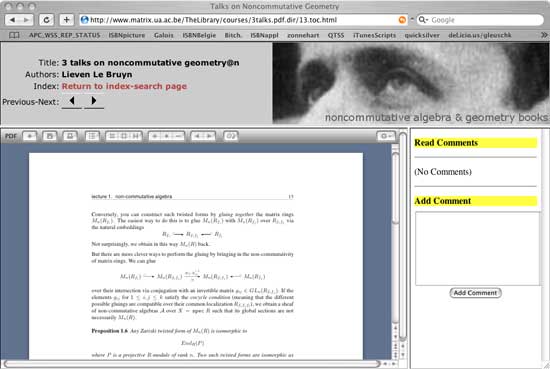A long
time ago Don Passman
told me the simple “secret” for writing books : “Get up and,
before you do anything else, try to write 2 or 3 pages. If you do this
every day, by the end of the year you’ll have a pretty thick book.”
Probably the best advice ever for those who need to get a thesis or book
finished. I’ve managed to live by this rule for several months in a
row (the first half of 2000 leading to version 2 and the winter of 2001-2002
resulting in version 3) and I can recommend it to
anyone in need for some (self)dicipline. It feels just like training,
hard in the beginning but after a couple of weeks you’re addicted.
Also the pitfalls are similar. On certain days you have so much energy
that it is easy to write 10 or more pages (or in the revision process,
to revise 30 or more pages). Don’t do it! Tomorrow you will be
exhausted and you will not be able to do a single page but you will
convince yourself that it is not needed as you did more than enough the
day before. And you’ll feel and say the same thing the day after, and
the next day! and before you realize it you’ll be way behind
schedule. So, rule 1 : do 2 pages mimimun, 3 or 4 if possible but never
more than 5!
Another useful bit of advice comes from
Lewis Caroll’s ‘Through the looking glass’ in which the Red
King says
Start at the beginning, then continue until
you reach the end. Then stop.
Too many bookprojects
never get past the planning stages. It is much more fun to dream up the
perfect book than it is to write the first paragraph. Also, when the
writing on chapter X goes slow, it is tempting to begin with chapter X+1
or any other chapter that seems like more fun, and before you know
you’ll end up with a complete mess (and believe me, I know what I’m
talking about here).
Armed with these two guiding rules I began
the new year writing version pi of my book. (Oh, a marginal note : some
people seem to think that I set up ‘NeverEndingBooks’ to get my
book published. It may surely be the case that I’ll get _a_
book published there, but _the_ book I promised already a long
time ago to the EMS-publishing
house! So, if you have an interesting bookproject for
‘NeverEndingBooks’ please contact us.) Anyway, the writing goes
slow! I’m already far behind schedule. So far I produced just over 20
pages! Part of the problem is that I want the book to be self-contained
and from past experiences with our ‘masterclass non-commutative
geometry’ I know that this means including a lot of elementary
material (it seems that sudents are eager on entering a masterclass on
non-commutative geometry without knowing the basics of either
non-commutative algebra or algebraic geometry). So. I started out with
believe it or not the definition of matrix-multiplication! But the book
has a pretty steap learning curve, by page 3 I’m already using
Grassmannians to classify left ideals in matrix-algebras! But I was
surprised how long it took me to come up with my own proofs of all this
‘trivial’ material. But the main problem is : lack of motivation.
I’m no longer convinced that one has to write technical books to aid
the younger generation. They are already far too technical!Perhaps it
would be far better to write books helping to develop creativity? But
how? And why are there so few of such books around. In fact, I know of
only one book trying to achieve this : An Invitation to General
Algebra and Universal Constructions By George Bergman. His chapter 0
‘about the course and these notes’ comes very close to how I would
like to teach masterclass courses or how I’d love to write books if
only I’d know how. Perhaps, over the next couple of weeks, I’ll use
this weblog again to write up a micro-course on noncommutative geometry,
some people tell me they begin to miss the mathematics on this
site.

